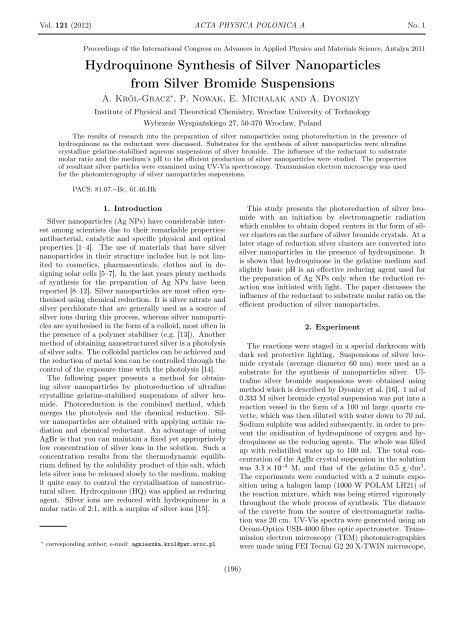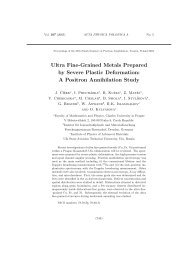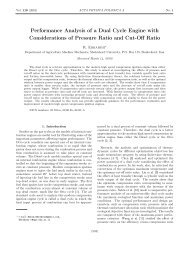Hydroquinone Synthesis of Silver Nanoparticles from Silver Bromide ...
Hydroquinone Synthesis of Silver Nanoparticles from Silver Bromide ...
Hydroquinone Synthesis of Silver Nanoparticles from Silver Bromide ...
You also want an ePaper? Increase the reach of your titles
YUMPU automatically turns print PDFs into web optimized ePapers that Google loves.
Vol. 121 (2012) ACTA PHYSICA POLONICA A No. 1<br />
Proceedings <strong>of</strong> the International Congress on Advances in Applied Physics and Materials Science, Antalya 2011<br />
<strong>Hydroquinone</strong> <strong>Synthesis</strong> <strong>of</strong> <strong>Silver</strong> <strong>Nanoparticles</strong><br />
<strong>from</strong> <strong>Silver</strong> <strong>Bromide</strong> Suspensions<br />
A. Król-Gracz ∗ , P. Nowak, E. Michalak and A. Dyonizy<br />
Institute <strong>of</strong> Physical and Theoretical Chemistry, Wrocław University <strong>of</strong> Technology<br />
Wybrzeże Wyspiańskiego 27, 50-370 Wrocław, Poland<br />
The results <strong>of</strong> research into the preparation <strong>of</strong> silver nanoparticles using photoreduction in the presence <strong>of</strong><br />
hydroquinone as the reductant were discussed. Substrates for the synthesis <strong>of</strong> silver nanoparticles were ultrafine<br />
crystalline gelatine-stabilised aqueous suspensions <strong>of</strong> silver bromide. The influence <strong>of</strong> the reductant to substrate<br />
molar ratio and the medium’s pH to the efficient production <strong>of</strong> silver nanoparticles were studied. The properties<br />
<strong>of</strong> resultant silver particles were examined using UV-Vis spectroscopy. Transmission electron microscopy was used<br />
for the photomicrography <strong>of</strong> silver nanoparticles suspensions.<br />
PACS: 81.07.−Bc, 61.46.Hk<br />
1. Introduction<br />
<strong>Silver</strong> nanoparticles (Ag NPs) have considerable interest<br />
among scientists due to their remarkable properties:<br />
antibacterial, catalytic and specific physical and optical<br />
properties [1–4]. The use <strong>of</strong> materials that have silver<br />
nanoparticles in their structure includes but is not limited<br />
to cosmetics, pharmaceuticals, clothes and in designing<br />
solar cells [5–7]. In the last years plenty methods<br />
<strong>of</strong> synthesis for the preparation <strong>of</strong> Ag NPs have been<br />
reported [8–12]. <strong>Silver</strong> nanoparticles are most <strong>of</strong>ten synthesised<br />
using chemical reduction. It is silver nitrate and<br />
silver perchlorate that are generally used as a source <strong>of</strong><br />
silver ions during this process, whereas silver nanoparticles<br />
are synthesised in the form <strong>of</strong> a colloid, most <strong>of</strong>ten in<br />
the presence <strong>of</strong> a polymer stabiliser (e.g. [13]). Another<br />
method <strong>of</strong> obtaining nanostructured silver is a photolysis<br />
<strong>of</strong> silver salts. The colloidal particles can be achieved and<br />
the reduction <strong>of</strong> metal ions can be controlled through the<br />
control <strong>of</strong> the exposure time with the photolysis [14].<br />
The following paper presents a method for obtaining<br />
silver nanoparticles by photoreduction <strong>of</strong> ultrafine<br />
crystalline gelatine-stabilised suspensions <strong>of</strong> silver bromide.<br />
Photoreduction is the combined method, which<br />
merges the photolysis and the chemical reduction. <strong>Silver</strong><br />
nanoparticles are obtained with applying actinic radiation<br />
and chemical reductant. An advantage <strong>of</strong> using<br />
AgBr is that you can maintain a fixed yet appropriately<br />
low concentration <strong>of</strong> silver ions in the solution. Such a<br />
concentration results <strong>from</strong> the thermodynamic equilibrium<br />
defined by the solubility product <strong>of</strong> this salt, which<br />
lets silver ions be released slowly to the medium, making<br />
it quite easy to control the crystallisation <strong>of</strong> nanostructural<br />
silver. <strong>Hydroquinone</strong> (HQ) was applied as reducing<br />
agent. <strong>Silver</strong> ions are reduced with hydroquinone in a<br />
molar ratio <strong>of</strong> 2:1, with a surplus <strong>of</strong> silver ions [15].<br />
∗ corresponding author; e-mail: agnieszka.krol@pwr.wroc.pl<br />
(196)<br />
This study presents the photoreduction <strong>of</strong> silver bromide<br />
with an initiation by electromagnetic radiation<br />
which enables to obtain doped centers in the form <strong>of</strong> silver<br />
clusters on the surface <strong>of</strong> silver bromide crystals. At a<br />
later stage <strong>of</strong> reduction silver clusters are converted into<br />
silver nanoparticles in the presence <strong>of</strong> hydroquinone. It<br />
is shown that hydroquinone in the gelatine medium and<br />
slightly basic pH is an effective reducing agent used for<br />
the preparation <strong>of</strong> Ag NPs only when the reduction reaction<br />
was initiated with light. The paper discusses the<br />
influence <strong>of</strong> the reductant to substrate molar ratio on the<br />
efficient production <strong>of</strong> silver nanoparticles.<br />
2. Experiment<br />
The reactions were staged in a special darkroom with<br />
dark red protective lighting. Suspensions <strong>of</strong> silver bromide<br />
crystals (average diameter 60 nm) were used as a<br />
substrate for the synthesis <strong>of</strong> nanoparticles silver. Ultrafine<br />
silver bromide suspensions were obtained using<br />
method which is described by Dyonizy et al. [16]. 1 ml <strong>of</strong><br />
0.333 M silver bromide crystal suspension was put into a<br />
reaction vessel in the form <strong>of</strong> a 100 ml large quartz cuvette,<br />
which was then diluted with water down to 70 ml.<br />
Sodium sulphite was added subsequently, in order to prevent<br />
the oxidisation <strong>of</strong> hydroquinone <strong>of</strong> oxygen and hydroquinone<br />
as the reducing agents. The whole was filled<br />
up with redistilled water up to 100 ml. The total concentration<br />
<strong>of</strong> the AgBr crystal suspension in the solution<br />
was 3.3 × 10 −4 M, and that <strong>of</strong> the gelatine 0.5 g/dm 3 .<br />
The experiments were conducted with a 2 minute exposition<br />
using a halogen lamp (1000 W POLAM LH21) <strong>of</strong><br />
the reaction mixture, which was being stirred vigorously<br />
throughout the whole process <strong>of</strong> synthesis. The distance<br />
<strong>of</strong> the cuvette <strong>from</strong> the source <strong>of</strong> electromagnetic radiation<br />
was 20 cm. UV-Vis spectra were generated using an<br />
Ocean-Optics USB-4000 fibre optic spectrometer. Transmission<br />
electron microscopy (TEM) photomicrographies<br />
were made using FEI Tecnai G2 20 X-TWIN microscope,
with an accelerating voltage <strong>of</strong> 120 kV. Microscope specimens<br />
were prepared by depositing the carbon-coated<br />
copper grids. The study used analytical purity reagents<br />
manufactured by POCH S.A. Poland.<br />
3. Results and discussions<br />
Photoreduction was conducted in the presence <strong>of</strong> actinic<br />
radiation or absence <strong>of</strong> light during the reduction <strong>of</strong><br />
ultrafine silver bromide suspensions. <strong>Hydroquinone</strong> was<br />
used as the reductant. The impact <strong>of</strong> the reductant to<br />
silver bromide molar ratio: 0.32, 0.62, 1.60 and 3.10 in<br />
the medium <strong>of</strong> constant pH <strong>of</strong> 8.7 was examined. Fig-<br />
Fig. 1. UV-Vis spectra <strong>of</strong> silver nanoparticles recorded<br />
after 20 h <strong>of</strong> the reduction <strong>of</strong> AgBr crystals in the<br />
presence <strong>of</strong> hydroquinone and without exposition to<br />
light. Molar ratio <strong>of</strong> HQ to AgBr was: 0.32, 0.62, 1.60,<br />
and 3.10.<br />
Fig. 2. UV-Vis spectra recorded after 20 h <strong>of</strong> the photoreduction<br />
<strong>of</strong> AgBr crystals in the presence <strong>of</strong> hydroquinone<br />
with 2 min exposition to light. Molar ratio <strong>of</strong><br />
HQ to AgBr was 0.32, 0.62, 1.60, and 3.10.<br />
ure 1 presents the UV-Vis spectrum obtained after 20 h<br />
<strong>of</strong> silver bromide crystals suspensions reduction in the<br />
presence <strong>of</strong> hydroquinone, without exposition to light.<br />
It was found that the reduction <strong>of</strong> ultrafine silver bromide<br />
crystals almost do not exist in the studied molar<br />
ratios <strong>of</strong> reactants and pH 8.7 despite the fact the pH<br />
<strong>Hydroquinone</strong> <strong>Synthesis</strong> <strong>of</strong> <strong>Silver</strong> <strong>Nanoparticles</strong> . . . 197<br />
Fig. 3. Position <strong>of</strong> an extinction band maximum <strong>of</strong> the<br />
Ag NPs obtained in different molar ratio <strong>of</strong> HQ to AgBr<br />
after the photoreduction with exposition to light.<br />
Fig. 4. Maximum extinction <strong>of</strong> the Ag NPs obtained<br />
in different molar ratio <strong>of</strong> HQ to AgBr after the photoreduction<br />
with exposition to light.<br />
limit in which the hydroquinone reaches a sufficiently low<br />
oxidation-reduction potential to reduce the silver bromide<br />
is 7.9 [17]. The probable reason for the lack <strong>of</strong><br />
reduction reaction in the absence <strong>of</strong> light, pH 8.7, in the<br />
presence <strong>of</strong> gelatine is too high value <strong>of</strong> the oxidation-<br />
-reduction potential barrier at which the hydroquinone<br />
does not reduce the crystals <strong>of</strong> silver bromide to silver. It<br />
is necessary to initiate this reaction e.g. by applied actinic<br />
radiation allowing the formation <strong>of</strong> doped centers in the<br />
form <strong>of</strong> clusters <strong>of</strong> silver on the surface <strong>of</strong> silver bromide<br />
crystals, which are converted into silver nanoparticles in<br />
the presence <strong>of</strong> hydroquinone.<br />
Figure 2 shows the spectral dependence obtained after<br />
20 h <strong>of</strong> photoreduction <strong>of</strong> silver bromide suspensions<br />
in different molar ratio <strong>of</strong> hydroquinone to the substrate<br />
and a constant pH <strong>of</strong> 8.7. This process was initiated by<br />
2 min exposure to light <strong>of</strong> the reaction mixture. <strong>Silver</strong><br />
nanoparticles obtained at a molar ratio <strong>of</strong> reductant to<br />
AgBr: 0.32, 0.62, 1.60, and 3.10 present the maximum extinction<br />
at a wavelength <strong>of</strong> 398, 410, 436, and 440 nm, respectively<br />
(Fig. 3). The extinction peaks shifted to longer<br />
wavelength and became narrower with the elevated molar
198 A. Król-Gracz et al.<br />
ratio, possibly due to decreased dispersion <strong>of</strong> size obtaining<br />
silver nanoparticles [18]. The plasmon effect, which<br />
is typical <strong>of</strong> spherically shaped Ag NPs, occurs in range<br />
<strong>from</strong> 390 to 440 nm, relating to size distribution <strong>from</strong> 4<br />
to 50 nm [19]. When reductant amount increased in the<br />
reaction medium, we observed extinction maximum increase<br />
in the range <strong>of</strong> 0.2 to 3-fold excess AgBr relative<br />
to HQ and the HQ <strong>of</strong> 1.8 for the 3-fold excess <strong>of</strong> reductant<br />
in relation to the substrate (Fig. 4). The results show a<br />
good linear correlation with R = 0.950. <strong>Hydroquinone</strong> reduction<br />
<strong>of</strong> silver bromide occurs at 2-fold excess <strong>of</strong> silver<br />
bromide stoichiometrically but reactions carried out in<br />
similar conditions (nHQ/nAgBr = 0.62) was relatively ineffective.<br />
Photoreduction reaction at a pH <strong>of</strong> 8.7 was most<br />
effective in three excess <strong>of</strong> hydroquinone (Fig. 2).<br />
Fig. 5. TEM photomicrographs, size percentage distribution and EDX spectrum <strong>of</strong> resultant silver nanoparticles<br />
obtained using the photoreduction in the presence hydroquinone.<br />
Analysis <strong>of</strong> the photomicrographs obtained using the<br />
TEM method and <strong>of</strong> chemical composition the energy<br />
dispersive X-ray (EDX) <strong>of</strong> silver nanoparticles (Fig. 5)<br />
demonstrated that the growth <strong>of</strong> molar ratio <strong>of</strong> hydroquinone<br />
to silver bromide causes decrease <strong>of</strong> average size<br />
<strong>of</strong> silver nanoparticles obtained and decrease the amount<br />
<strong>of</strong> unreacted silver bromide in the range <strong>of</strong> 30% for the<br />
molar ratio <strong>of</strong> HQ to AgBr 0.62 to 4.4% for the 3-fold<br />
excess <strong>of</strong> hydroquinone. Population <strong>of</strong> silver particles<br />
obtained in molar ratio reductant to AgBr <strong>of</strong> 3.10 has a<br />
smaller size and shape dispersion <strong>of</strong> silver particles than<br />
silver obtained in excess <strong>of</strong> AgBr as evidenced by the size<br />
distribution histograms <strong>of</strong> silver nanoparticles (Fig. 5).<br />
The population <strong>of</strong> silver nanoparticles obtained at the<br />
molar ratio <strong>of</strong> AgBr to HQ 0.62 characterized by the dispersion<br />
<strong>of</strong> particle size <strong>from</strong> 16 nm to 100 nm but was<br />
dominated by structures with a diameter <strong>of</strong> 45 nm and<br />
54 nm. The resultant population prepared in the 1.6-<br />
-fold excess <strong>of</strong> reductant to the substrate was in the size<br />
range 18 nm to 100 nm but with the dominant population<br />
<strong>of</strong> silver by 35 nm and 45 nm in diameter. The<br />
most monodisperse <strong>of</strong> silver nanoparticles was obtained<br />
in the population <strong>of</strong> 3-fold excess <strong>of</strong> hydroquinone to<br />
AgBr, the average size <strong>of</strong> silver particles obtained was<br />
approximately 30 nm. It can also be concluded <strong>from</strong> the<br />
TEM photomicrographs that the particles obtained are<br />
spherically shaped and do not tend to aggregate.<br />
4. Conclusions<br />
Described is a method <strong>of</strong> using the photoreduction, in<br />
the presence <strong>of</strong> hydroquinone as the reductant, <strong>of</strong> ultrafine<br />
crystalline suspensions <strong>of</strong> silver bromide in a gelatine<br />
protection to obtain silver nanoparticles. The paper discusses<br />
the influence <strong>of</strong> the reductant to substrate molar
atio on the efficient production <strong>of</strong> silver nanoparticles.<br />
We show that HQ is unable to reduce isolated silver ions<br />
but is able to reduce the same ions when added onto pre-<br />
-existing silver metallic clusters. In this study we show<br />
that UV radiation can be used to initiate the HQ reduction<br />
<strong>of</strong> AgBr and then the radiation can be removed<br />
to allow HQ to finish the Ag NPs growth on its own<br />
in dark. TEM analysis confirmed that silver particles<br />
formed were shaped almost spherically, with a majority<br />
<strong>of</strong> structures ranging <strong>from</strong> 15 nm to 65 nm in diameter.<br />
Tests performed using a spectrometer indicated that it<br />
is possible to obtain silver nanoparticles with their maximum<br />
extinction rates ranging <strong>from</strong> 400 to 440 nm. The<br />
plasmon effect, which is typical <strong>of</strong> spherically shaped silver<br />
nanoparticles, occurs in this range. The presented<br />
method <strong>of</strong> obtaining nanostructural silver makes it possible<br />
to produce silver particles, featuring intense plasmon<br />
absorption at a wavelength in the range <strong>from</strong> 400 nm to<br />
440 nm, in an easy and efficient way. The resulting colloidal<br />
silver has the shape close to spherical and has no<br />
tendency to aggregation.<br />
Acknowledgments<br />
The study conducted under research project N508<br />
488938 is financed <strong>from</strong> the Ministry <strong>of</strong> Science and<br />
Higher Education for 2010–2011.<br />
References<br />
[1] K.A. Moores, F. Goettmann, New J. Chem. 30, 1121<br />
(2006).<br />
[2] X. Chen, H.J. Schluesener, Toxicology Lett. 176, 1<br />
(2008).<br />
[3] K. Mallick, W. Witcom, Mater. Chem. Phys. 97, 283<br />
(2006).<br />
[4] S. Wijnhoven, W. Peijnenburg, C. Herberts, W. Hagens,<br />
A. Oomen, E. Heugens, B. Roszek, J. Bisschops,<br />
I. Gosens, D. van de Meent, S. Dekkers, W. de Jong,<br />
M. van Zijverden, A. Sips, R. Geertsma, Nanotoxicology<br />
3, 109 (2009).<br />
<strong>Hydroquinone</strong> <strong>Synthesis</strong> <strong>of</strong> <strong>Silver</strong> <strong>Nanoparticles</strong> . . . 199<br />
[5] P. Gupta, M. Bajpai, S. Bajpai, J. Cotton. Sci. 12,<br />
280 (2008).<br />
[6] E. Vesseur, R. Waele, M. Kuttge, A. Polman, Nano<br />
Lett. 7, 2843 (2007).<br />
[7] T. Tolaymat, A. Badawy, A. Genaidy, K. Scheckel,<br />
T. Luxton, M. Suidan, Sci. Tot. Environ. 408, 999<br />
(2010).<br />
[8] Y. Qin, X. Ji, J. Jing, H. Liu, H. Wu, W. Yang, Colloids<br />
Surf. A 372, 172 (2010).<br />
[9] T. Tsujia, D.H. Thanga, Y. Okazakib, M. Nakanishib,<br />
Y. Tsuboic, M. Tsujia, Appl. Surf. Sci. 254, 5224<br />
(2008).<br />
[10] K. Bhainsa, S. D’Souza, Colloids Surf. B 47, 160<br />
(2006).<br />
[11] R. He, X. Qian, J. Yin, Z. Zhu, J. Mater. Chem. 12,<br />
3783 (2002).<br />
[12] J. Talebi, R. Halladj, S. Askari, J. Mater. Sci. 45,<br />
3318 (2010).<br />
[13] J. Widoniak, S. Assmann, G. Maret, Colloids Surf. A<br />
270-271, 340 (2005).<br />
[14] N. Kometani, H. Doi, K. Asami, Y. Yonezawa, Phys.<br />
Chem. Chem. Phys. 4, 5142 (2002).<br />
[15] S. Gentry, S. Fredericks, R. Krchnavek, Langmuir 25,<br />
2613 (2009).<br />
[16] A. Dyonizy, P. Nowak, A. Król-Gracz, E. Michalak,<br />
Chemik 64, 33 (2010).<br />
[17] T. James, The Theory <strong>of</strong> the Photographic Process,<br />
4th ed., Macmillan Publishing Co. Inc., New York<br />
1977, p. 300.<br />
[18] M. Cobley, M. Rycenga, F. Zhou, Zhi-Yuan Li,<br />
Y. Xia, J. Phys. Chem. C 113, 16975 (2009).<br />
[19] A. Slistan-Grijalva, R. Herrera-Urbina, J. Rivas-Silva,<br />
M. Avalos-Borja, F. Castillo-Barraza, A. Posada-<br />
-Amarillas, Physica E 27, 104 (2005).





